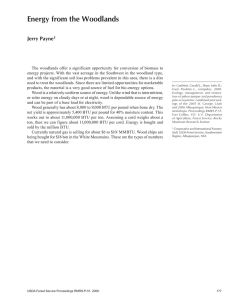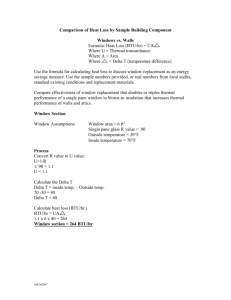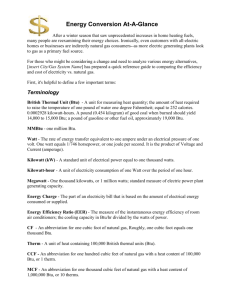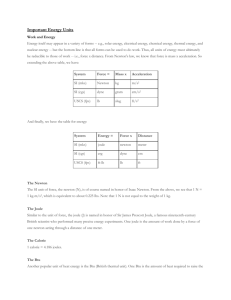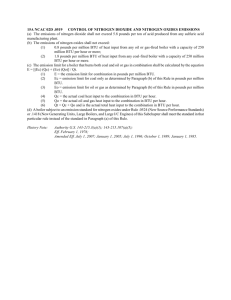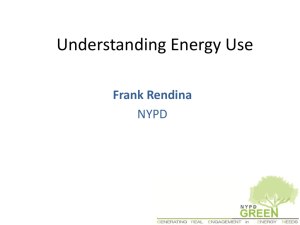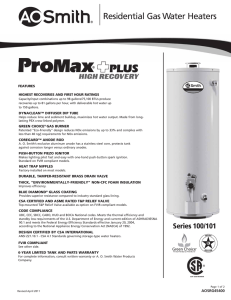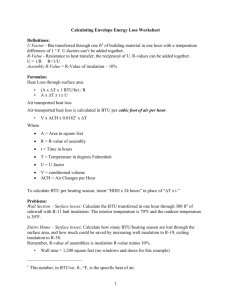I llSC' Locker and Home Cold- Some Engineering Aspects of
advertisement
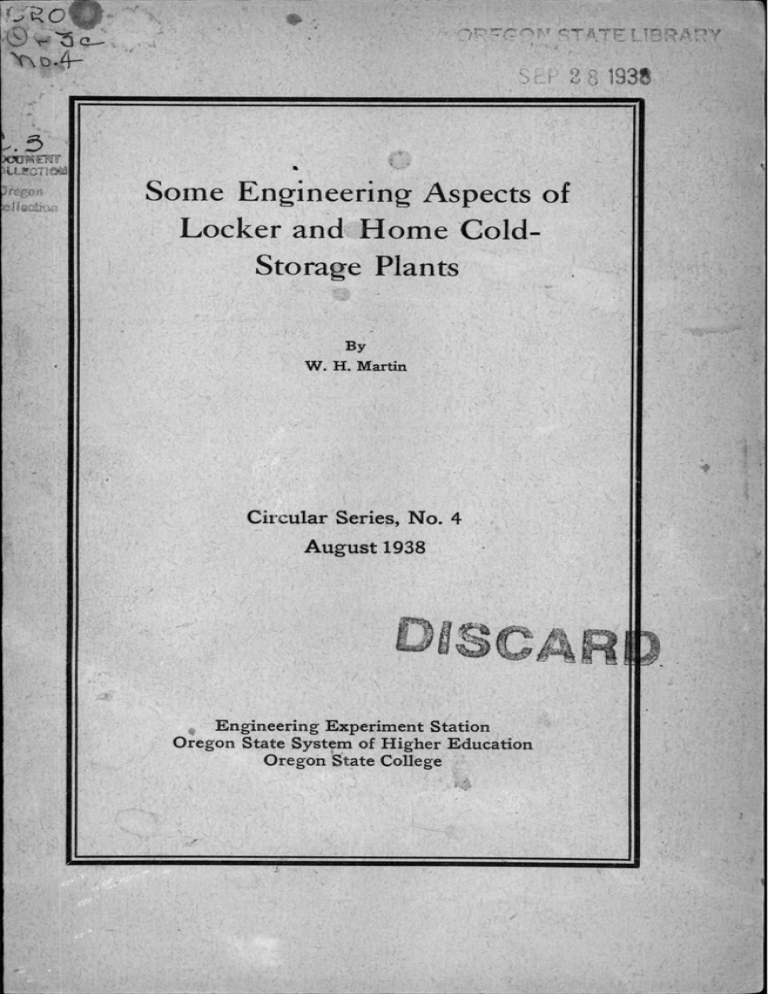
2 8 1938 t Some Engineering Aspects of Locker and Home ColdStorage Plants By W. H. Martin Circular Series, No. 4 August 1938 llSC' Engineering Experiment Station Oregon State System of Higher Education Oregon State College I THE Oregon State Engineering Experiment Station was established by act of the Board of Regents of the College on May 4, 1927. It is the purpose of the Station to serve the state in a manner broadly outlined by the following policy: (1)To stimulate and elevate engineering education by developing the research spirit in faculty and students. (2) To serve the industries, utilities, professional engineers, public departments, and engineering teachers by making investigations of interest to them. (3) To publish and distribute by bulletins, circulars, and technical articles in periodicals the results of such studies, surveys, tests, investigations, and researches as will be of greatest benefit to the people of Oregon, and particularly to the state's industries, utilities, and professional engineers. To make available the results of the investigations conducted by the Station three types of publications are issued. These are: (1) Bulletins covering original investigations. (2) Circulors giving compilations of useful data. (3) Reprints giving more general distribution to scientific papers or reports previously published elsewhere, as for example, in the proceedings of professional societies. Single copies of publications are sent free on request to residents of Oregon, to libraries, and to other experiment stations exchanging publications. As long as available, additional copies, or copies to others are sent at prices covering cost of printing. The price of this bulletin is 20 cents. For copies of publications or for other information address Oregon State Engineering Experiment Station, Corvallis, Oregon Some Engineering Aspects of Locker and Home ColdStorage Plants By W. H. MARTIN, Professor of Heat Engineering Circular Series, No. 4 August 1938 Engineering Experiment, Station Oregon State System of Higher Education Oregon State College TABLE OF CONTENTS Page Prefatory Note -------------------------------------------------------------------------------------------- 3 Acknowledgments ---------------------------------------------------------------------------------------- 3 III. Refrigerating Plant Refrigeration Cycle -------------------------------------------------------------------------2. Compressor Capacity 3 4 3. Power Requirements ------------------------------------------------------------------------- 5 I. II. 1. ------------------------------------------------------------------------ IV. Locker Storage 1. 2. 3. 4. Floor Plan -------------------------------------------------------------------------------------------- 6 Heat Leakage -------------------------------------------------------------------------------------- 8 Piping 9 Chill Room ------------------------------------------------------------------------------------------ 5. Compressor Capacity 10 ------------------------------------------------------------------------ 10 Freezer -------------------------------------------------------------------------------------------------- 11 Insulation ---------------------------------------------------------------------------------------------- 13 8. Insulation Calculations -------------------------------------------------------------------- 16 V. Small Combined Freezer and Storage ---------------------------------------------------- 17 6. 7. FIGURES Figure 1. Flow Diagram of a Simple Refrigerating Plant........................ Figure 2. Volume of Ammonia Circulated per Ton-Minute-------------------Figure 3. Power Requirements for Ammonia Compressors -------------------- Figure 4. Floor Plan for Typical Locker Storage Plant -------------------------Figure 5. Insulation Details for Wall, Floor, and Ceiling---------------------- 5 6 7 8 15 Some Engineering Aspects of Locker and Home Cold-Storage Plants By W. H. MRTIN, Professor of Heat Engineering I. PREFATORY NOTE THE many inquiries regarding locker cold-storage plants and requests for information on cold-storage cabinets for home use, particularly on farms, indicate that there is a need of engineering information to supplement that available from manufacturers of equipment and supplies used in such plants. This publication has been prepared with the object of supplying information in a manner that may be easily understood by the layman. II. ACKNOWLEDGMENTS The preparation of this material was made possible through the cooperation of a number of individuals and organizations. Among these were: Northwest Baker Ice Machine Co., Mr. F. W. Knowles, Seattle, Washington, Western Cooperage Company, Mr. R. C. Marson, Portland, Oregon, Pacific Lumber Co., San Francisco, California, Northwest Cold Storage Locker Association. The writer also expresses his thanks to Professors E. H. Wiegand and Thomas Onsdorff, of the Department of Food Products Industries, for their cooperation; and to S. H. Graf, Director of Engineering Research, for suggesting this study and for his critical review of the copy. III. REFRIGERATING PLANT 1.Refrigeration cycle. The mechanical refrigeration cycle consists of a series of processes including evaporation, compression, and condensation. A liquid, when it evaporates, absorbs heat from its surroundings. As an example, one pound of water absorbs 970 Btu when it changes from liquid to vapor at atmospheric pressure. Ammonia (a commonly used refrigerant) when it evaporates at atmospheric pressure absorbs about 590 Btu per pound. Another refrigerant that has come into use in recent years is dichloro-difluoro-methane, known commercially as Freon or F-12. One pound of this refrigerant when evaporated at atmospheric pressure absorbs about 72 Btu. The boiling temperatures for these substances when vaporized at at- mospheric pressure are respectively 212 F, 28 F, and 21.6 F. If the evaporating pressure is decreased the boiling temperature is decreased. 3. 4 ENGINEERING EXPERIMENT STATION CIRCULAR No. 4 For any given pressure there is a corresponding boiling or condensing temperature, and conversely, for every boiling or condensing temperature there is a corresponding pressure. The relationship of the temperature and pressure is a property of the substance. These properties have been determined and published by the United States Bureau of Standards* and other research agencies. The temperature desired in an evaporator determines the pressure that must be maintained in it. Let us suppose that we have a room that we wish to hold at 5 F. We place pipe coils along the ceiling. Warm air is lighter than cold air and will rise to the ceiling. By evaporating refrigerant in these coils at a temperature less than 5 F heat will be caused to flow to the cold pipe surface. In order that the temperature may be held at a low level inside of the coil, however, the vapor must be removed as rapidly as it forms so as to hold the pressure in the coils constant. If a lower temperature is necessary the pressure will have to be lower. The main purpose of the compressor is to pump the vapor out of the evaporator as fast as it forms. Obviously, there is a direct relation between the displacement of the compressor and the volume of vapor that must be removed. There is also a relation among the volume of vapor, the amount of heat that is absorbed, and the temperature and pressure in the evaporator. We shall discuss this in a more concrete manner in our illustrative calculations. The compressor raises the pressure of the refrigerant vapor and discharges it into a heat exchanger called the condenser. At the higher pressure the vapor can be condensed at ordinary temperature by removing heat from it by means of water or air. The condensed liquid is passed back to the evaporator through a reducing valve, commonly called an expansion valve, and the process is repeated. Figure 1 shows diagrammatically the arrangement of a simple refrigerating plant. 2. Compressor capacity. Capacity of refrigerating plants is measured in "tons." The ton is a measure of the rate at which heat is absorbed in the evaporator and is equivalent to the amount of heat that is absorbed when one ton of ice melts in 24 hours. The latent heat of fusion of ice is 144 Btu per pound. The heat absorbed when one ton melts is 2,000X 144 or 288,000 Btu. This quantity expressed in Btu per hour is 12,000, or 200 Btu per minute. A compressor is said to have a capacity of one ton when it has sufficient displacement to remove from the evaporator the volume of refrigerant vapor that is produced by the absorption of 200 Btu per minute. This volume is a function of the weight of refrigerant that must be evaporated to absorb the 200 Btu and of the specific volume, which in turn is a function of the pressure. To illustrate, let us suppose that the refrigeration requirements of a certain room are one ton and that the temperature in the evaporator is 0 F. Also let the liquid come to the expansion valve at 80 F. If ammonia is the refrigerant, the heat contained in the liquid is 132 Btu per pound. After the ammonia has evaporated, its heat content will have increased to 611.8 Btu per pound. The net heat absorbed in the evaporator is 611.8-132.0 or 479.8 Btu per pound. This is called the refrigerating effect per pound. Since one ton is the removal of heat at the rate of 200 Btu per minute the 'Circu1ar No. 142 of the United States Bureau of Standards. Available from Superintendent of Documents, Government Printing Office, Washington, D. C. Price 15 cents. LOCKER AND HOME COLD-STORAGE PLANTS number of pounds of ammonia that will have to be evaporated and pumped out by the compressor is 200/479.8 or 0.416 per minute. The volume of ammonia vapor coming from the evaporator is 9.12 cubic feet per pound, and the effective displacement of the machine must be 0.416X9.12 or 3.79 cubic feet per minute. Now suppose that the evaporator is operating at 10 F. The weight of refrigerant that must be circulated to produce refrigeration at the rate of one ton is very nearly the same, but the volume per pound is 7.3 cubic feet and'the capacity is 9.12/7.3 or 1.25 times as great. It is quite evident from these illustrative values that when specifying the capacity of a compressor the evaporating temperature or the suction pressure, and the discharge pressure, must also be specified if the rating is to have any significance. The magnitude of the effect of suction and discharge pressures on effective displacement is well shown by Figure 2. Discharge pressure in pounds per square inch gage is plotted as abscissa and effective displacement in cubic feet per ton-minute as ordinate. The exact relationship is so nearly direct that it is shown on the diagram by straight lines. CONDENSER PRESSURE HIGH PA. GAGE THERMOMETER FOR COOLING WATER INLET 9 DISCHARGE GAS CONDENSER THERMOMETER LIQUID LOW PR.GAGE I coMpREssoR SUCTION GAS THERMOMETER RECEIVER \ I _______________________________ THERMOMETER FOR COOLING WATER OUTLET LID LEVEL GAGE GLASS EAPANSION VALVE EVAPORATOR W THERMOMETER IN ROOM OR LIQUID BEING COOL ED Figure 1. Flow diagram of a simple refrigerating plant. The effect of discharge pressure on effective displacement is not great. Its effect on actual displacement, however, is considerable because the volumetric efficiency decreases as discharge pressure increases. The effect of suction pressure is very marked. The required compressor displacement with 0 suction pressure is practically twice the amount necessary when the suction pressure is at 15 pounds gage. 3. Power requirements. In the illustrative example just cited the evaporating or suction pressure for the first case is 30.4 pounds per square inch absolute and for the second case 23.7 pounds absolute. The condensing pressure corresponding to 80 F is 153 pounds absolute. Obviously it 55' ENGINEERING EXPERIMENT STATION CIRCULAR No. 4 6 takes more horsepower to drive a compressor that is pumping vapor from a pressure of 23.7 pounds to 153 pounds than is required for pumping from 30.4 to 153 pounds. It is a well-known fact that the power requirements for low evaporating temperatures are greater than for high temperatures. The I0 z 0 I- 8 Ui a- I U.. 6 0 I- z Ui 4 I_ I i__i I !__ 1 I___ U SUCTION PRESSURE, LB PER SQ IN GAGE 2 o 100 120 140 160 180 HEAD PRESSURE, LB PER SQ IN GAGE Figure 2. Volume of ammonia circulated per ton-minute. power requirements for a medium-sized machine with reasonable allowance for efficiency are shown by Figure 3. Discharge pressure in pounds per square inch gage is plotted as abscissa and horsepower per ton as ordinate. For each suction pressure a different line shows the relationship. It will be observed that for any given suction pressure the horsepower input to the compressor increases as discharge pressure increases. This increase is so nearly a straight line relationship that it is so indicated. Also for low suction pressure the energy requirements are greater than for high suction pressures. Energy consumption of the driving motor is lowest, for any given plant capacity, when the suction pressure is as high as is consistent with maintenance of proper temperatures and when discharge pressure is as low as can be economically maintained. IV. LOCKER STORAGE 1.Floor plan. The floor plan of a locker storage plant is largely dictated by the local conditions. There are, however, certain factors that should be taken into consideration. In order to have some way by which S LOCKER AND HOME COLD-STORAGE PLANTS 7 we may illustrate our discussion let us use the floor plan shown in Figure 4. The customer coming in passes the office where it is easy to keep a check on everyone who enters. He passes through the cutting room, then through a corner of the chill room into the locker room proper.. If anyone is about the plant at all it would be practically impossible for a stranger to get to the locker room without being seen. As a precaution against theft this is an important consideration. The goods being brought in pass directly to the cutting and processing room or can be taken on to the chill room. When ready they need be moved only a short distance to the cutting room and again only a short distance to the freezer. From the freezer they can be quickly distributed to the individual lockers. The cutting room serves as an anteroom to the chill room and reduces the heat leakage and number of air changes in that room. The chill room serves the same purpose with respect to the locker room and the locker room with respect to the freezer. The result is that not as much frost accumulates on the coils as would be the case if these rooms opened directly to the outside. Also if a customer should leave a door open the heat loss is not as great. This floor plan is not offered as a model but merely to illustrate some of the engineering aspects of the problem. Locker owners and managers undoubtedly will find quite different plans adapted to their individual situations. Size of plant, variety of services rendered, auxiliary business, and other factors, all should be considered in laying out the floor plan. The more nearly square the insulated section of the plant is, the smaller will be 4 z 0 w a- 0 100 120 140 160 HEAD PRESSURE, LB PER SQ IN GAGE Figure 3. Power requirements for ammonia compressors. 180 ------ , 8 ---,- -. ENGINEERING EXPERIMENT STATION CIRCULAR No. 4 the investment in insulating material. The methods of analysis used in this case, however, are applicable to any similar situation. 2. Heat leakage. The heat that must be removed from a room is made up of several items. Heat leakage through walls, floor, and roof constitutes an appreciable amount; other items are heat due to lights and to people who may be in the rooms, heat due to entrance of warm air when doors are opened, and heat to be removed from goods. In a locker storage it is practically impossible to estimate all of these quantities even approximately. The heat leakage can be estimated with fair accuracy. We shall proceed to show how this may be done. The outside air temperature for summer can be taken at 70 F as a 24hour average in most parts of Oregon, and in cold-storage work it is the 24hour average that is important rather than the daily maximum. The ground temperature can be taken at about 50 F. For a locker room maintained at 5 F', the temperature gradient through the floor is 50-5 or 45 degrees, while through the outside walls and ceiling it is 70-5 or 65 degrees. For any given construction the heat-transfer coefficient can be computed as shown in the section on insulation. A coefficient of 0.05 Btu per square foot per hour per degree F. is reasonable. In the case of insulation where inexpensive filler is used the wall can be made thick and a lower coefficient obtained. The south wall of the locker room shown is 36 feet long. If the ceiling is 10 feet high the area is 360 square feet. The heat leakage is H UA(t1t2), where U is the heat-transfer coefficient in Btu per square foot per hour per degree,, A is the area of the wall in square feet, and (t1t2) is the temperature gradient through the wall in degrees. The heat leakage through this wall then is 0.05X360X65, or 1,170 Btu per hour. N .UrO.O35 COMP. FREEZER IE° CHILL ROOM ROOM ' LAy. S UO65 w STORES LOCKER ROOM E 36 x 36 CUlliNG ROOM U O.05(" S Figure 4. Floor plan for typical locker storage plant. OFFICE LOCKER AND HOME COLD-STORAGE PLANTS 9 As the west wall is the same size and all other values are equal, the leakage is also 1,170 Btu per hour. The north wall is 26 feet long and the area is 260 square feet. The heat leakage is 0.05X260X65, or 845 Btu per hour. The wall next the freezer is 21 feet long and the area 210 square feet. The recommended freezer temperature is 15 F. The temperature gradient is from 5 F to 15 F or 20 degrees and the heat leakage is negative and equal to 0.05X210X20 or 210 Btu per hour. The distance along the wall next to the chill room, which is held at 32 F, is 10 feet and the area 100 square feet. The temperature gradient is 32-5 or 27 degrees. Heat leakage is 0.05X100X27, or 135 Btu per hour. The side next to the cutting room is about 15 feet long and the area is 150 square feet. The cutting-room temperature can be taken at about 60 F, which gives a temperature gradient of 60-5 or 55 degrees. Heat leakage is 0,05X150X55, or 412 Btu per hour. The gross area of ceiling is 36X36, or 1,296 square feet. Deducting for the area above the freezer, 9X10 or 90 square feet, the net area is 1,296-90 or 1,206 square feet. Heat leakage is 0.O5Xl,206X65 or 3920 Btu per hour. These figures can all be summarized in tabular form and a similar procedure followed in the cases of other rooms. Surface South wall West wall North wall Freezer wall Wall net to chill room Wall next to cutting room Ceiling (net) Floor (net) Temperature 1-Teat leakage per hour gradient Coefficient Dimensions Area Feet 36X10 36X10 26X10 21X10 Square feet 360 360 260 210 0.05 0.05 0.05 0.05 20 lOX 10 100 0.05 27 135 1SX1O 150 0.05 55 412 1,206 1,206 0.05 0.05 65 45 3,920 2,720 36X36 less 9X10 Degrees F Tota ....................................................... 65 65 65 I ............. Btu 1,170 1,170 845 210 10,162 3. Piping. Experience indicates that if locker rooms are piped on the basis of 3.5 cubic feet of space per foot of U-inch pipe satisfactory operation is obtained. The liberal use of pipe makes possible a small temperature difference between pipe and air in the room, which, in turn, makes possible fairly high humidity. When the air in the room comes in contact with the cold pipe surface it is cooled to the dew-point temperature. This air mixes with the remaining air, and the average dew point approaches that corresponding to the temperature of the pipe surface. Small difference between room temperature and pipe-surface temperature allows of maintenance of a higher dew point and higher humidity, which results in less dehydration of goods in storage. It also allows use of a higher suction pressure than could be employed if less pipe were used, a condition that contributes to more economical operation. The gross volume of the room is 36X36X10, or 12,960 cubic feet. The volume occupied by the freezer is 9X1OX1O, or 900 cubic feet. This leaves a net volume of the locker room of 12,060 cubic feet. The number of feet of pipe required in this case is 12,060/3.5 or 3,450. It requires 2.3 lineal feet of 11-inch pipe to furnish 1 square foot of surface. The number of square feet of surface is 3,450/2.3 or 1,500. On the basis of 10 degrees difference between evaporating temperature and room temperature the heat-absorbing - - ENGINEERING EXPERIMENT STATION CIRCULAR No. 4 10 capacity of the pipe in the room is approximately 2 Btu per square foot per hour per degree, and the total heat-absorbing capacity is H=UA(t1t2)= 2X1,500X10=30,000 Btu per hour. Since this is approximately three times the amount of heat leakage, there is a margin of about 20,000 Btu per hour to provide for refrigeration of goods and other items. Under storage conditions when no new goods are being brought in and when other losses are small, it will be necessary for the compressor to operate only about onethird of the time. 4. Chill room. The chill room should be large enough to hang meat for a long enough period to age it properly. There is no standard size agreed upon among operators. For purpose of illustration a room about 8X20X10 feet high is suggested. The volume is 1,600 cubic feet. Experience indicates that an allowance of 7 cubic feet of space per lineal foot of 11inch pipe is reasonable. The total number of feet of pipe is 1,600/7, or 229, which has an area of practically 100 square feet. The coils should be placed about 8 to 12 inches below the ceiling, with a sloping insulated baffle underneath to catch any moisture that drips off the coils. These coils will usually be connected to the suction of the same com- pressor that serves the locker room. The evaporating temperature is 5 F, and since the room is to be held at about 32 F the temperature difference is 37 degrees. The heat that the coils will absorb is H=UA(t1t2)= 2X100X37=7,400 Btu per hour. By using the same method as was used in computing the heat leakage for the locker room, the heat leakage into the chill room can be estimated. Surface West wall next freezer West wall next locker South wall East wall North wall Ceiling ------------------Floor Total leakage ----------------------- Dimensions Feet 11X 10 9X 10 8X10 203< 10 8X10 8X20 8X20 Area Coefficient Square feet 110 90 80 200 80 160 160 0.035 0.05 0.05 0.05 0.05 0.05 0.05 'Temperature Heat leakage per hour difference Degrees F Btu 47 27 28 38 38 38 18 181 .-121 112 380 152 304 144 790 In order to hold the room the coils need to be in operation 790/7,400 or 0.106 or 10.6 per cent of the time. If meat is brought in at 90 F and cooled to 32 F, the amount of heat that must be removed to cool a pound is practically (90-32) 0.7 or 40.6 Btu. The specific heat of meat can be taken at 0.7. The margin of 7,400-790 or 6,610 Btu is enough refrigeration to cool 6,610/40.6 or 162 pounds per hour. 5. Compressor capacity. The compressor to serve the locker room and chill room should have enough capacity to compress the vapor that results from the use of all the coil surface in both rooms. The capacity of the coil in the locker room is 30,000 Btu per hour and that of the chill room is 7,400 Btu per hour, making a total of 37,400 Btu per hour. This is 37,400/12,000 or 3.12 tons, as a ton is 12,000 Btu per hour. With cooling water entering the condenser at 70 F and leaving at 80 F the discharge pressure will be about 145 pounds gage. For an evaporating temperature of 5 F the suction pressure is 12.2 pounds gage. From Figure 2 the effective displace- LOCKER AND HOME COLD-STORAGE PLANTS 11 ment necessary is found to be about 4.4 cubic feet per ton-minute. The total effective displacement is 3i2X4.4 or 13.7 cubic feet per minute. A pound of ammonia vapor at 5 F has a heat content of 610 Btu and a pound of liquid ammonia at 145-pound gage a heat content of 135 Btu. The difference 610-135 or 475 Btu is the amount of heat absorbed by each pound in the evaporator. The amount of ammonia that will have to be circulated per hour is 37,400/475 or 78.8 pounds. This is 78.8/60 or 1.31 pounds per minute. At 5 F the volume of one pound of ammonia vapor is 10.23 cubic feet. The effective displacement of the compressor then is 1.31X10.23 or 13.4 cubic feet per minute as against 13.7 obtained by use of Figure 2. A reasonable volumetric efficiency is about 77 per cent which would make the actual displacement 13.4/0.77 or 17.4 cubic feet per minute. For this service a two-cylinder machine would probably be used. A 4 inch X 4 inch, two-cylinder, single acting compressor running at 300 rpm will be about the proper size. The power requirement can be read from the diagram in Figure 3. For the conditions given it is 1.93 brake horsepower per ton and the total horsepower is 1.93X3.12 or 6.02. The next larger standard size electric motor should be chosen. 6. Freezer. Many locker storages do not have sharp freezers, but it is a well-known fact that products frozen quickly are of better quality than slowly frozen goods. Meat and other products if placed on shelves in a room at 10 or 15 degrees below zero will freeze much more rapidly than when placed directly in a locker where the temperature is only 10 F. The size of the freezer need not be large. If we estimate the amount of product to be frozen per day at 1,000 pounds and allow a shelf area based on 8 pounds of packaged goods per square foot of shelf area, the amount of shelf area necessary is 125 square feet. Shelves can be conveniently made of pipe placed 6 inches apart horizontally and 18 inches apart vertically. Six pipes placed side by side with a galvanized iron sheet laid on top of the pipes will make a very satisfactory shelf about 36 inches wide. By placing 5 of theseshelves, one about 18 inches above another, along one side of a room 9 feet long, sufficient shelf area is made available. An aisle about 30 inches wide is ample for passageway, and if an additional 30 inches is allowed for hanging of goods to be frozen in that manner, enough capacity is provided for a plant with about 500 lockers. This requires a room 8 feet wide by 9 feet long inside. Shelf coils should be made of straight pipe lengths slightly shorter than the length of the room. The ends should be connected by return bends in such a way that the first pipe of each shelf is connected at one end to the first pipe of the shelf below and the other end connected to the corresponding pipe of the shelf above. There will be as many separate elements as there are pipes in each shelf, six in this case. Each element should be supplied with liquid refrigerant at the bottom and the vapor removed at the top. Either 11-inch pipe or 2-inch pipe can be used for shelf coils, but 2-inch is preferable. With 2-inch coils the internal area of the pipe is large enough for the vapor to separate from the liquid and flow along the top, whereas in the case of 1+-inch pipe the vapor does not separate from the liquid so readily, and the liquid is ca?ried along in slugs. It is important to get the vapor out as quickly as possible in order that the coil may operate efficiently. 12 ENGINEERING EXPERIMENT STATION CIRCULAR No. 4 In addition to the shelf coils there should be coils on the ceiling with a space of at least 8 inches between the ceiling and the top of the pipes to facilitate air circulation. The ceiling coils, will have 16 pipes, and if the room is 8 feet long these coils can be considered 9 feet long, counting the return bends. The number of pipes in the shelf coils is 6 per shelf, thus five shelves give 30 lengths in the shelf coils. The total number of lengths is then 16+30 or 46, and at 9 feet per length this amounts to 9X46 or 414 lineal feet of pipe. A room 8 feet X 9 feet X 10 feet high has a volume of 720 cubic feet. The number of cubic feet of room space per lineal foot of pipe is 720/414 or about 1. Many sharp freezers have less pipe than this, but large pipe surface contributes to more economical operation. Increased efficiency can also be obtained by operating the freezer coils flooded by any one of the approved methods. In order to estimate the machine capacity 2 Btu per square foot per hour per degree may be used as the heat-transfer coefficient, a freezer temperature of 15 F, and an evaporating temperature of 25 F. The amount of surface in 414 lineal feet of 2-inch pipe is 414/1.6 or 259 square feet. The amount of heat the pipe will absorb is UA (trte), where U is the heat- transfer coefficient in Btu per square foot per hour per ° F, A is the surface of evaporator in square feet, tr is the room temperature in ° F, and te is the evaporating temperature in °F. Numerically this then gives: Heat absorbed =2X259X(10) or 5,180 Btu per hour. To cool and freeze a pound of meat requires approximately 110 Btu. Some meat requires more and some less. One thousand pounds of meat require ilOX 1,000 or 110,00Q Btu. If this load is spread over 24 hours the heat to be absorbed per hour is about 4,580. This allows us a margin of 5,1804,580 or 600 Btu/hr to provide for leakage and other losses. The method of estimating the size of compressor for the freezer is as follows: The volume of a pound of ammonia at 25 F is 16.66 cubic feet. The total heat of dry vapor is 603.2 Btu per pound. If the liquid comes to the expansion valve at 80 F it will have 132 Btu per pound. The refriger- ating effect per pound is 603.2-13247l.2 Btu. To absorb 5,180 Btu per hour it is necessary to circulate 5,180/471.2 or practically 11 pounds of ammonia per hour. This is lix 16.66 or 183.3 cubic feet per hour. The effective displacement of the compressor is 183.3/60 or 3.05 cubic feet per minuth. By using Figure 2 we get a displacement of 3.02 cubic feet per minute. A single cylinder compressor 3 inches X 3 inches at about 250 revolutions per minute will have sufficient capacity, although slightly higher speed would allow more margin to provide for emergency loads. The machine should be so controlled automatically as to maintain a constant coil temperature of about 25 F. In the floor plan the freezer has been placed inside of the locker room proper. There are several advantages in this arrangement. The air in the locker room is at a low dew point and when it gets into the freezer as the door is opened it does not carry as much vapor into the room as warmer air would and hence frost does not accumulate so quickly. The heat leakage can more easily be kept low, nd much of the loss of refrigeration from the freezer room goes to the locker room instead of escaping to the outside. By careful planning, the distance the goods must be moved to transfer them from the freezer to the locker is reduced. LOCKER AND HOME COLD-STORAGE PLANTS 13 7. Insulation. The success or failure of any kind of cold storage is largely due to the effectiveness of the insulating material used. There are several materials that are in more or less common use for preventing heat leakage through walls, floors, and ceilings. Cork has long been used for low-temperature insulation. It has a high resistance to heat flow. This property is largely due to the fact that cork is a cellular material and each of the cells contains air. Air is one of the best insulators known and any material that contains small air cells is a good insulator. The mote thoroughly the air is confined the better the insulating characteristics are. Many socalled dead air spaces allow more or less circulation of the air and to the extent that they do permit circulation, their value is reduced. Insulating materials may be divided into two general classes: those that have both insulating value and structural strength, and those that have insulating value only. Certain insulating materials such as cork and rock cork are available in board or block form and have sufficient structural strength to be used for self-supporting partition walls. Other materials such as shavings, sawdust, "Flakewood," redwood bark fiber, and quilt materials must be held in place by additional structure. In erecting any kind of insulation, the recommendations of the manufacturers should be carefully followed. The most important consideration in- any cold-storage insulation is moisture. Every possible effort should be made to build cold-storage walls airtight because if they are not airtight, they will not be moisture proof. Moisture tends to travel through a wall from the warm to the cold side. It enters the wall on the warm side as a vapor but as it penetrates the wall, its temperature drops as it approaches the cold side, and when the dew point is reached, condensation begins. If the temperature is below freezing, the moisture freezes and not only reduces the resistance of the wall to heat flow, but causes rapid deterioration. In order to illustrate the process by which moisture penetrates a waIl, it may be assumed that the air on the warm side is at 70 F and 50 per cent relative humidity. The water vapor in air is steam, and the pressure of this steam is equal to the pressure corresponding to the temperature, as given in the steam tables, multiplied by the relative humidity. The pressure of saturated water vapor at 70 F is 0.74 inch of mercury. If the relative humidity is 50 per cent, the actual pressure of the vapor is 0.5X0.74 or 0.37 inch of mercury. Now suppose a room is to be held at 10 F and 90 per cent relative humidity. The pressure of saturated water vapor at 10 F is 0.063 inch of mercury and, if the relative humidity is 90 per cent, the actual pressure is 0.9X0.063 or 0.0567 inch. The difference in pressure of the vapor on the two sides of the wall is 0.370.0567 or 0.3133 inch of mercury. This pressure difference is equivalent to about 22.5 pounds per square foot. By way of comparison, the maximum wind pressure used in design of exposed surfaces such as bridges, chimneys, and high buildings is only about 30 pounds per square foot. Obviously, the pressure available to drive vapor through a wall may be very large, and the greatest care must be used to make the warm side of the wall air- tight. Some designers advocate waterproofing both sides of the wall. Others maintain that the cold side should not be made airtight but should be vented to allow any moisture that may be in the wall to escape into the cold room. As there is no tendency for moisture to penetrate the wall from the cold side because of vapor-pressure difference, it is not so necessary to make the cold side airtight. If the warm side is airtight, however, no mois- 14 ENGINEERING EXPERIMENT STATION CIRCULAR No. 4 ture can penetrate and there will be no need to provide for venting the cold side. Furthermore, if moisture can enter it will not pass through instantly and the result is a wet wall, which is a poor insulator. Again, let the importance be emphasized of making outside surface of all insulated walls airand vapor-tight. One of the most satisfactory methods of waterproofing where boardor block-type insulation is used is the application of a coat of hot asphalt to the outer surface. If the insulation is laid up against another wall of brick, concrete, or other rigid construction, a coat of waterproofing should be applied and the blocks laid up in asphalt in at least two layers with all joints broken. Manufacturers of insulating materials on request will furnish typical specifications for proper installation of their products. In the case of insulating materials having no structural strength, a wall constructed in such a manner that the insulation serves as a filler is necessary. The approved method is to build a hollow wall each side of which consists of two thicknesses of tongued and grooved boards with two or more layers of heavy waxed or asphalt-impregnated building paper between. On the cold side the paper can be omitted. Any paper having a pronounced odor should not be used. Each double thickness of boards should be nailed to vertical studs spaced 18 inches apart on centers. The studs should be inside of the wall. Those studs to which the sheathing that forms the outside of the wall is nailed should be staggered with respect to those supporting the inside. Ties consisting of 1x4 in. pieces spaced about three feet apart vertically and nailed to one side of one 2x4 in. stud and the opposite side of the one across, will strengthen the wall. For walls of ordinary height, say ten feet, 2x4 in. studs are sufficiently rigid. For higher walls 2x6 in. studs are more satisfactory. Plywood may be used instead of one or both thicknesses of tongued and grooved sheathing. Shiplap also has been used. The hollow wall is filled with insulating material packed only to such density that it will not settle and leave an open air space at the top. The approved type of floor construction consists of a solid subfloor, preferably concrete, and provided with thorough drainage. Sleepers of 2x3 in. or 2x4 in. are spaced 18 inches apart and laid flat on the subfloor. On these sleepers two thicknesses of tongued and grooved lumber with two or more thicknesses of heavy waxed or asphalt-impregnated paper between are laid. Joists of 2x4 in. or 2x6 in., depending on the desired thickness of floor, are next laid on edge at right angles to the sleepers and spaced 18 inches apart. Another layer of joists at right angles to the first completes the skeleton of the floor. At points where joists cross, a thickness of waterproof paper placed between them is recommended. The space is then filled with the insulating material. A floor made up of two layers of 2x4 in. joists and sleepers will provide for about 7I inches of insulation in addition to the four thicknesses of lumber, and if the joists are 2x6 in. the thickness of insulation is 11 inches. The top of the subfloor should be thoroughly waterproofed. The top floor should consist of two thicknesses of lumber with the usual paper between. The ceiling construction should be of two layers of joists at right angles with two thicknesses of the same kind of sheathing as is used in the wails, nailed to the under side of the joists to form the ceiling and two thicknesses on top with paper between to provide an. airtight seal. The intervening space is filled with insulating material. Additional construction 15 LOCKER AND HOME COLD-STORAGE PLANTS may be necessary to provide for support of the ceiling, depending on the distance from wall to wall. In some cases where the floor must be supported on piers or posts a heavier type of joist construction such as 2x10 in. or heavier must be used 4t" TA 1' Plvwnnd nr .chinl,,n Plates notched into Studs CEILING Studs, ie"O.C. WALL I'x4"T/e,3-o'O.0 FLOOR\ \ Flooring \ Stop paper here Paper Jois/ 34" T&G, Plywood or Ship/op \ ' P/ate z'xs"-ie"OC.' Pap 3/4"T& G, Plywood or Figure 5. Insulation details for wall, floor, and ceiling. I8'OC 16 ENGINEERING EXPERIMENT STATION CIRCULAR No. 4 and the checker type of skeleton is not adaptable. In all cases the building paper in the ceiling and floor should extend around the corner and should lap with the paper in the wall so as to form a continuous vapor-tight envelope. Walls of this general type of construction, filled with kiln-dried planer shavings, "Flakewood", or redwood bark fiber give excellent results and long life when workmanship is good. The details shown in Figure 5 illustrate some of the more important features of the floor, wall, and ceiling construction. 8. Insulation calculations. The insulating value of a wall depends on the resistance to heat flow offered by the material in the wall. In order to illustrate the method of computation to follow in calculating the insulating value it may be assumed that a wall consists of two thicknesses of i-inch sheathing on each side with 8 inches of fill insulation between. Conductivity of a material is expressed in terms of Btu that can get through a square foot of the material 1 inch thick in 1 hour when the temperature difference on the two sides of the material is 1 degree Fahrenheit. Abbreviated, it is, Btu per square foot per hour per degree per inch thickness. The resistance is the reciprocal, or 1/conductivity. The total resistance is the sum of all the individual resistances. The over-all heat transfer is the reciprocal of the total resistance, or 1/total resistance. In the illustrative case there are four -inch thicknesses of fIr sheathing. Fir lumber, across the grain, has a conductivity value of practically 1. The resistance offered by the four thicknesses is (4X0.75)/1, or 3. If the fill-type insulation used in this case has a conductivity of 0.33 the total resistance offered by 8 inches is 8/0.33, or 24. The inside surface of the wall will offer some resistance because of the stagnant film of air next to the surface. This can be taken at 0.7. The resistance of the outer surface can be neglected without serious error as the air circulates over this surface fast enough to keep the stagnant film fairly well scrubbed off. The total resistance then is 3+24+0.7, or 27.7. The heat transfer is 1/27.7 or 0.036 Btu per square foot per hour per degree. This is called the heat-transfer coefficient for the wall and is designated by the letter "U". The value of U for any given case can be expressed by a formula as follows: In this expression ti is the thickness of the material for which k1 is the conductivity, and so on for t2 k2, and ta ka for as many different kinds of material as make up the wall. The quantity 1/k4 is the form of resistance factor for a surface. The value for k for a surface is not given in terms of the thickness but in terms of the conductivity of the film. No appreciable error is made if the surface resistance is neglected in calculating the coefficient for cold-storage walls because the surface effect is small'compared to the resistance of the insulation. The same is true of building walls outside of the insulation, particularly brick or concrete walls. In order to decide how much insulation to use in any given case it is a good plan to make a study from the standpoint of economics. If costs of insulation and of refrigeration are known i.t is possible to find the most economical wall thickness. To illustrate, let us suppose that we are con- LOCKER AND HOME COLD-STORAGE PLANTS 17 sidering a wall that has a coefficient of 0.05. What will be the effect if an additional inch of insulating material having a conductivity of 0.31 Btu per square foot per hour per degree per inch thickness is used? The coefficient for the thicker wall will be 1 1 0.05 _= 20+3.22 =0.043 ± 0.31 If the temperature difference is 65 degrees the heat transfer through the wall in the first case will be 0.05X653.25 Btu per square foot per hour, while for the second casq it will be 0.043X65=2.80. Increasing the thickness of the insulation 1 inch will effect a saving of 0.45 Btu of refrigeration per square foot per hour or 3,940 Btu per square foot per year. With electrical energy costing 2 per kwhr and a power requirement of 1.8 kw per ton the saving in the power bill is 1.8X2X3,940/12,000, or 1.l8 per year. In order to save this amount the fixed charges, including interest, depreciation, taxes, and insurance, at 18 per cent, 1.18/0.18 or 6.56 cents could be invested to break even. Whether or not the thicker wall is used should depend on whether it costs less or more than 6.56 cents per square foot for the extra inch of insulation. Obviously if the cost is less the extra inch should be used. Each inch that is added will show a smaller saving than the one immediately preceding, and when a thickness is reached where the saving does not exceed the fixed charges on the additional investment any further addition of insulation will result in an actual loss. V. SMALL COMBINED FREEZER AND STORAGE A small unit adapted to the use of one or two families can be built in the same manner as fhe larger storage. A room to be held at 32 F for storing vegetables and dairy products and for short-time storage of meat, with another smaller room inside held at 0 F for freezing meat makes a very satisfactory installation. A well-insulated walk-in type of unit having a total space capacity of about 300 cubic feet with a freezer capacity of about 75 cubic feet can be refrigerated with a unit of to 1 horsepower. The amount of coil surface for the freezer should be equivalent to about 1 lineal foot of 11-inch pipe per cubic foot of freezer space. On the basis of an evaporating temperature of refrigerant of 10 F and a room temperature of 0 F this amount of surface will absorb heat at the rate of about 660 Btu per hour. The heat leakage into such a room can be computed in the same manner as was illustrated previously. If well insulated, it is about 250 Btu per hour. The difference, or 410 Btu, is sufficient refrigeration to freeze meat at the rate of about 4 pounds per hour or nearly 100 pounds per day when the compressor is operating continuously. Under conditions when no new goods are being placed in the freezer the operating time will be approximately 40 per cent of the total time. The cooler can be piped with a ratio of about 4 cubic feet of space to 1 lineal foot of 1-inch pipe or equivalent surface. As only one compressor would be used for the whole unit the evaporating temperature in these coils would be the same as in the freezer coils and the temperature difference would be large, the coil surface would not need to be as large in 18 ENGINEERING EXPERIMENT STATION CIRCULAR No. 4 proportion. A room of 225 cubic feet would have about 56 lineal feet of 1-inch pipe, which has a surface of 19 square feet. The heat-absorbing capacity of this amount of surface is about 1,600 Btu per hour. The estimated heat leakage into a room of this type, properly insulated, is about 200 Btu per hour. The difference, or 1,400 Btu per hour, is available for cooling products. This is enough refrigeration to cool 10 gallons of milk from about 60 F to 40 F. The estimated capacity of a refrigerating unit for the whole space is 660+1,600 or 2,260 Btu per hour when operating continuously. From manufacturers' rating tables for the type of unit desired a compressor can be selected that, when operating with a suction pressure corresponding to an evaporating temperature of 10 F, has sufficient capacity to carry the load. The automatic controls for the unit are an important item. The temperature of the cooler should not be allowed to go below 32 F for there will be danger of freezing some of the goods. A thermostatically controlled expansion valve that will shut off the refrigerant to the cooler coils when the room temperature reaches 32 F is probably the most satisfactory for this room. In the case of the freezer an evaporating temperature of 10 F should be maintained. This can be accomplished by a thermostatic element attached to the coils at the outlet end, or by a pressure-controlled expansion valve. The compressor should be controlled so as to be stopped when neither room requires refrigeration and started by a demand from either room. The coils should be in parallel so that each operates independently. The suction lines are connected, however, and precautions should be taken to prevent vapor from the coils in the cooler from passing into the coils in the freezer when the compressor is not running. If this should occur the evaporation in the coils in the cooler would cause that room to get too cold and condensation in the coils in the freezer would cause its temperature to rise. When the compressor is shut down there is a tendency for the pressure in the coils in the cooler to rise and a check valve so located as to prevent flow into the freezer coil should be installed. Other more elaborate devices such as magnetic stop valves on the suction lines from both rooms, which are closed by the same thermostat that closes the expansion valves, are often used. The closing of both suction and expansion valves eliminates the possibility of the coils filling with liquid when the expansion valve does not close tightly. The operating costs of small units are higher in proportion than for large units for several reasons. The rates for electrical energy in small amounts are higher and the heat leakage is larger in proportion to the volume of storage space. When doors are opened the possibility of loss of cold air from the room is a larger proportion of the room volume than is the case in large rooms. Consequently particular attention should be given to insulation. A wall with a transfer coefficient of about 0.04 is recommended for the cooler and a coefficient of about 0.03 for the freezer. If a cork, or equal, block-type insulation is used a thickness of about 8 inches for the cooler and about 10 inches for the freezer is recommended. If a fill type of insulation is used these thicknesses should be 8 inches and 12 inches for fill material, or about 11 inches and 15 inches over-all including sheathing. PUBLICATIONS OF THE ENGINEERING EXPERIMENT STATION BulletinsNo. 1. Preliminary Report os the Control of Stream Pollution in Oregon, by C. V. Langton and H. S. Rogers. 1929. Fifteen cents. No. 2. A Sanita1y Survey of the Willamette Valley, by H. S. Rogers, C. A. Mockmore, and C. I). Adams. 1930. Forty cents. No. 3. The Properties of Cement-Sawdust Mortars, Plain, and with Various Admixtures, y S. H. Graf and R. H. Johnson. 1930. [wenty cents. No. 4. Interpretation of Exhaust Gas Analyses, by S. H. Graf, G. W. Gleeson, and W. H. Paul. 1934. Twenty-five cents. No. 5. Boiler-Water Troubles and Treatments with Special Reference to Problems in Western Oregon, by R. E. Summers. 1935. Twenty-five cents. No. 6. A Sanitary Survej of the Willamette River from Sellwood Bridge to the Colum. bia, by (,. W. (,leeson. 1936. Twenty.five cents. No. 7. Industrial and Domestic Wastes of the Willamette Valley, by G. W. Gleeson and F. Merryfield. 1936. Fifty cents. No. 8. An Investigation of Some Oregon Sands with a Statistical Study of the Predictive Values of Tests, by C. E. Thomas and S. H. Graf. 1937. Fifty cents. CircularsNo. 1. A Discussion of the Properties and Economics of Fuels Used in Oregon, by C. E. Thomas and G. D. ICeerins. 1929. Twenty-five cents. No. 2. Adjustment of Automotive Carburetors for Economy, by S. H. Graf and G. W. Gleeson. 1930. None available. No. 3. Elements of Refrigeration for Small Commercial Plants, by Wallace H. Martin. 1935. None available. No. 4. Some Engineering Aspects of Locker and Home Cold-Storage Plants, by Wallace H. Martin. 1938. Twenty cents. ReprintsNo. 1. Methods of Live Line Insulator Testing and Results of Tests with Different Instruments by F. 0. McMillan. Reprinted from 1927 Proc. N. W. Elec. Lt. and Power Twenty cents. Summers. Reprinted from Jan. 1935, Combustion. Ten cents. No. 3. Asphalt Emulsion Treatment Prevents Radio Interference, by F. 0. McMillan. Reprinted from Jan. 1935, Electrical West. Ten cents. No. 4. Some Characteristics of A-C Conductor Corona, by F. 0. McMillan. Reprinted from Mar. 1935, Electrical Engineering. Ten cents. No. 5. A Radio Interference Measuring Instrument, by F. 0. McMillan and H. G. Barnett. Reprinted from Aug. 1935, Electrical Engineering. Ten cents. No. 6. Water-Gas Reaction Apparently Controls Engine Exhaust Gas Composition, by No. 2. Some Anomalies of Siliceous Matter in Boiler Water Chemistry, by R. E. G. W. Gleeson and W. H. Paul. Reprinted from Feb. 1936, National Petro- leum News. Ten cents. No. 7. Steam Generation by Burning Wood, by R. E. Summers. Reprinted from April 1936, Heating and Ventilating. Ten cents. No. 8. The Piezo Electric Engine Indicator, by W. H. Paul and K. R. Eldredge. Reprinted from Nov. 1935, Oregon State Technical Record. Ten cents. No. 9. Humidity and Low Temperatures, by W. H. Martin and E. C. Willey. Reprinted from Feb. 1937, Power Plant Engineering. None available. No. 10. Heat Transfer Efficiency of Range Units, by W. J. Walsh. Reprinted from Aug. 1937, Electrical Engineering. None available. No. 11. Design of Concrete Mixtures, by I. F. Waterman. Reprinted from Nov. 1937, Concrete. None available. No. 12. Water-Wise Refrigeration by W. H. Martin and R. E. Summers. Reprint from July 1938, Power. Ten cents. Research Papers (Published as indicated. Not available from the Station.). No. 1. Electric Fish Screens, by F. 0. McMillan. Bulletin of the U. S. Bureau of Fisheries, vol. 44, 1928. Also in pamphlet form, U. S. Bureau of Fisheries, Document No. 1042. No. 2. Water Control of Dry Mixed Concrete, by G. W. Gleeson. Concrete Products, December 1929. No. 3. High-voltage Gaseous Conductor Lamps, by, F. 0. MeMillan and E. C. Starr. Trans. American Institute of Electrical Engineers, vol. 48, no. 1, pp. 11-18, 1929. No. 4. The Influence of Polarity in High-voltage Discharges, by F. 0. McMillan and E. C. Starr. Trans. American Institute of Electrical Engineers, vol. 50, no. 1, pp. 23.35, 1931. No. 5. Progress Report on Radio Interference from High.voltage Transmission Lines Pin and Pedestal Type Insulators, by F. 0. McMillan. Trans. 8th annual general meeting, Engineering Section, Northwest Electric Light and Power Assoc., 1931. No. 6. Aggregate Grading for Tamped Concrete Pipe by G. W. Gleeson. Concrete, June 1932. Rock Products, 1932. Concrete Products, June 1932 and May. June 1934. No. 7. Water Control of Dry Mixed Concrete, by G. W. Gleeson. Concrete Products, September 1932, and Rock Products, November 1932. No. 8. Litharge and Glycerine Mortars, by G. W. Gleeson. Paper Trade Journal, October 13, 1932. No. 9. Radio Interference from Insulator Corona, by F. 0. McMillan. Trans. American Institute of Electrical Engineers, vol. 51, no. 2, pp. 385-391, 1932. No. 10. The Coordination of High-voltage Transmission Lines with Radio, by F. 0. McMillan. Trans. 9th annual general meeting, Engineering Section, Northwest Electric Light and Power Assoc., 1932. No. 11. Asphalt Emulsion Reduces Insulator Radio Troubles, by F. 0. McMiJlan. Electrical World, vol. 102, no. 6, August 5, 1933. No. 12. Silicoo, a Major Constituent of Boiler Scales in Western Oregon. by R. E. Summers and C. S. Keevil. Paper presented at annual meeting, American Society of Mechanical Engineers, 1933. Abstracts published in Mechanical Engineering, vol. 55, p. 720, November 1933; Power, vol. 77, p. 687, midDec., 1933; and Power Plant Engineering, vol. 37, p. 519, December 1933, and vol. 38, p. 219, May 1934. No. 13. Study of the Frequency of Fuel Knock Noises, by W. H. Paul and A. L. Albert. National Petroleum News, August 9, 1933. No. 14. The Pollutional Character of Flax Retting Wastes, by G. W. Gleeson, F. Herryfield, and E. F. Howard. Sewage Works Journal, May 1934. No. 15. Siliceous Scales in Boilers of Western Oregon and Wasbington, by R. E. Summers and C. S. Keevil. The Timberman, vol. 35, p. 30, May 1934. No. 16. How Much Phosphate? by R. E. Summers. Power, vol. 78, p. 452, August 1934. No. 17. The Carbon Dioxide-Hydrogen Ratio in the Products of Combustion from Automotive Engines, by G. W. Gleeson and W. H. Paul. National Petroleum News, September 15, 1934. No. 18. Exhaust Gas Analysis by G. W. Gleeson and W. H. Paul. Parts I, II, and III. National Petroleum I1ews, September 26, October 3 and 10, 1934. No. 19. Simplified Measurements of Sound Absorption, by A. L. Albert and T. B, Wagner. Electrical Engineering, vol. 53, no. 8, p. 1,160, August 1934. No. 20. Treatment and Recovery of Sulfite Waste, by F. Merryfield. Civil Engineering, June 1936. No. 21. Industrial Wastes in the Willamette Valley, by F. Merryfield. Civil Engineering, October 1936. No. 22 Flow Characteristics in Elbow Draft-Tubes, by C. A. Mockmore. Proc. American Society of Civil Engineers, vol. 63, no. 2, pp. 251-286, Feb. 1937. No. 23. Some Simple Experiments Dealing with Rates of Solution, by G. W. Gleeson. Journal of Chemical Education, vol. 15, no. 4, April 1938. No. 24. Heat Transfer Coefficient in Boiling Refrigerant, by W. H. Martin. Refrigerat. jog Engineering, vol. 36, no. 3, September 1938. ..BEDljE in the Library on the last date given fine of O1 CENT will charged f THE ENGINEERING EXPERIMENT STATION STAFF R. H. DEARBORN, Dean and Director of Engineering. S. H. GRAF, Director of Engineering Research. A. L. ALBERT, Communication Engineering. F. A. EVEREST, Radio Engineering. G. W. GLEESON, Chemical Engineering. BURDErrE GLENN, Highway Engineering. J. R. GRIFFITH, Structural Engineering. E. G. MASON, Forestry. F. 0. MCMILLAN, Electrical Engineering. W. H. MARTIN, Mechanical Engineering. FRED MERRYFTELD, Sanitary Engineering. C. A. MOCKMORE, Civil and Hydraulic Engineering. W. H. PAUL, Automotive Engineering. B. F. RUFFNER, Aeronautical Engineering. E. C. STARR, Electrical Engineering. C. E. THOMAS, Engineering Materials. GLENN VOORHIES, Wood Products. Technical Counselors R. H. BwocK, State Highway Engineer, Salem. R. G. DIECK, Consulting Civil Engineer, Portland. PAUL B. McKEE, President, Portland Gas and Coke Company, Portland. 5. H. POLHEMUS, Executive Vice President, Portland Electric Power Company. J. C. H. Lee, Colonel, Corps of Engineers, Division Engineer, North Pacific Division, Portland. J. C. STEVENS, Consulting Civil and Hydraulic Engineer, Portland. C. E. STRICKLIN, State Engineer, Salem. Oregon State College Corvallis RESIDENT INSTRUCTION Liberat Arts and Sciences THE LOWER DIVISION (Junior Certificate) SCHOOL OF SCIENCE (BA., B.S., MA., MS., Ph.D. degrees) The Professional and Technical Curricula ScHooL OF SCHOOL OF AGRICULTURE (B.S., MS., Ph.D. degrees) EDUCATION (BA., ES., B.S. in Ed., M.A., M.S., Ed.M., Ed.D. degrees) SCHOOL OF ENGINEERING AND INDUSTRIAL ARTS (B.S., MS., OLE., C.E., E.E., M.E. degrees) (B.S., M.S., M.F., F.E. degrees) ScHOOL OF FORESTRY SCHOOL OF SCHOOL OF HOME ECONOMICS (BA., B.S, M.A., M.S. degrees) PHARMACY (B.S., M.S. degrees) SECRETARIAL SCIENcE (B.S.S. degree) The Graduate Division (MA., MS., Ed.M., M.F., Ch.E., CE., E.E., FE., ME., Ed.D., Ph.D. degrees) The Summer Sessions The Short Courses RESEARCH AND EXPERIMENTATION The General Research Council The Agricultural Experiment Station The Central Station, Corvallis The Union, Moro, Hermiston, Talent, Burns, Astoria, Hood River, Pendleton, Medford, and Squaw Butte Branch Stations The Engineering Experiment Station, Corvallis EXTENSION Federal Cooperative Extension (Agriculture and Home Economics) General Extension Division
